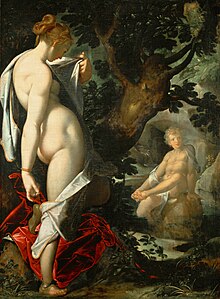Salmakis


Salmakis ( Greek Σαλμακίς , Latin Salmacis) is a figure from Greek mythology , a nymph who is the only one of the Naiads (according to Ovid) who does not appear to belong to Artemis . According to mythology, she combined with the hermaphroditus to form a single bisexual being. Salmakis is also the name of the spring where Salmakis is said to have lived.
Autonomy of the Salmakis
The best known version of this myth comes from Ovid's Metamorphoses . Here it is told why Salmakis is not counted among Artemis', the hunting goddess, following and why she had a special position among the nymphs. There it says in lines 302 to 315:
- Who inhabits it (note: the source) , the nymph 'is incapable of hunting, and never
- If she draws the bow taut, she may still be zealous in the race,
- From the Naiads alone, quite a stranger to the agile Diana.
- The sisters often said to her - so the legend reports -:
- Salmakis, take the skewer, the delicately made quiver,
- And swap comfortable leisure with the invigorating hunt!
- But she doesn't take the spit, nor the delicately made quiver,
- May not exchange comfortable leisure with the strengthening hunt,
- But in the water of the spring it washes the irritating limbs,
- Brush your hair straight with the comb of Cytorian boxwood
- Or ask what looks beautiful on you, the reflecting waves;
- With a see-through dress also more often surround the body
- Sometimes swelling leaves, sometimes swelling grass choose them for bed;
- Often she picks flowers.
Salmakis separated herself from her companions even before she met the son of Hermes and was vain and complacent.
Tradition of the Hermaphroditos story
On his way from his home, where he grew up on Mount Ida in Phrygia , to Halicarnassus in Caria , Hermaphroditos meets Salmakis. She thought he was Cupid and immediately fell in love with him. However, the fifteen-year-old Hermaphroditus rejects them. However, when he accidentally bathed in her spring at a later point in time , she hugged him and pulled him down with her to the bottom.
At Ovid this is described as follows:
- "Victory! he is mine! ”So calls the Naiad ', and every shell
- Hurls them away and throws themselves right into the waves
- Holds the quarrel and steals kisses as they wrestle,
- Pushes under his hands and touches the defending breast,
- And now she hugs here, now she hugs the youth there.
- Finally she thinks how much he is reluctant and tries to escape,
- Knitted around him like the snake that the king bird carries away
- And lift up into the air - while floating it wraps him around him
- Feet and head and wraps his tail around the spread wings -
- Or like ivy grows on towering trunks,
- Or how under the flood the polyp attacks its opponent
- Holds with his fangs, which he stretches to either side.
- Atlas' sprout holds up and refuses the nymph the joys,
- Which she longs for. She pushes and speaks as she is close to the youth
- Obedient to himself: 'How much, cruel one, you resist,
- But you do not escape me. So may, it says, you gods,
- For those of me no day, no day separate me from that!
Here she prayed to the gods that they both may be united forever. She was heard and both bodies merged. They became a hybrid , with female dimensions and breasts , but male genitals . This new being, also called Hermaphroditos, prayed that all people who bathed in this spring would meet this fate. Hermaphroditos parents, Hermes and Aphrodite listened to this request, and from now on the source turned people into hermaphrodites . Vitruvius, however, attests that the spring is tasty water and denies that the water makes sexually ill or emasculates .
Salmakis in ancient times
In the city of Halicarnassus, near which the source of the Salmakis was located, there was a district called like the nymph. There was also a Hermaphroditus sanctuary there. The name of the Salmakis comes from the language of Asia Minor . The story in which Hermaphroditos meets Salmakis is only a secondary, young saga about the young son of gods. It may be an invention of Ovid, who wanted to explain the figure of Hermaphroditus.
Salmakis in art and music
In ancient art , but also in the Renaissance and early modern times , the legend was a popular motif for artists. There were mostly two styles. Salmakis was portrayed either as a pretty, amorous nymph, or as a rather clumsy, lustful and ugly creature who chases after the young man.
Musically, the nymph Salmakis in “The Fountain of Salmacis” was processed by the rock group Genesis in their album “ Nursery Cryme ” (1971).
A literary adaptation of the subject can be found in the novel " Middlesex " by Jeffrey Eugenides , which was awarded the Pulitzer Prize in 2003.
Individual evidence
- ↑ Ovid: Salmacis and Hermaphrodit (3rd daughter) . In: Metamorphoses . 4th book, p. Lines 302-315 ( available online [accessed August 18, 2008] Latin: Metamorphoseon libri . Translated by R. Suchier).
- ↑ Ovid: Salmacis and Hermaphrodit (3rd daughter) . In: Metamorphoses . 4th book, p. Lines 356–373 ( available online [accessed August 18, 2008] Latin: Metamorphoseon libri . Translated by R. Suchier).
literature
- Carsten Binder: Salmakis , In: Der Neue Pauly Vol. 10 (2001), Sp. 1259f.
- G. Karl Galinsky: Ovid's Metamorphoses. An Introduction to the Basic Aspects. Univ. of California Press, Berkeley, Blackwell, Oxford 1975. ISBN 0-520-02848-1




